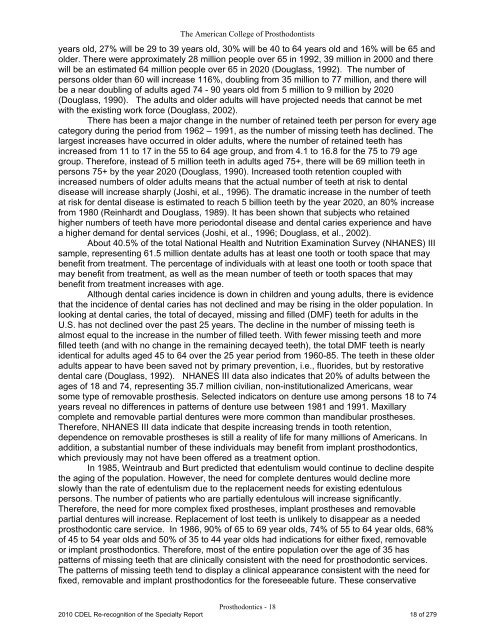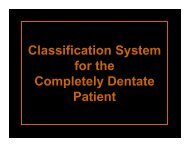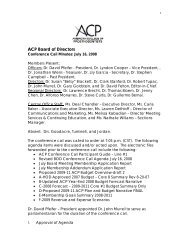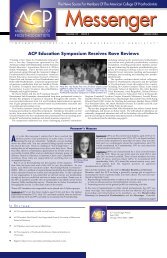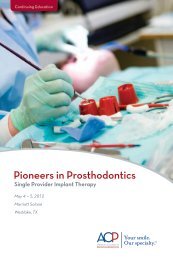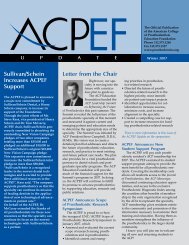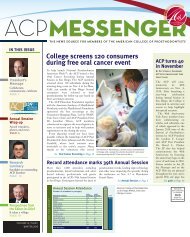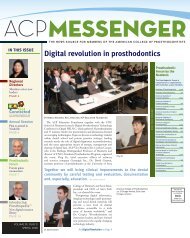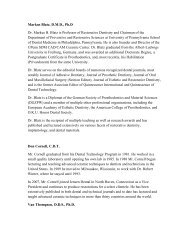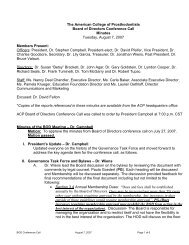PROSTHODONTICS - American College of Prosthodontists
PROSTHODONTICS - American College of Prosthodontists
PROSTHODONTICS - American College of Prosthodontists
Create successful ePaper yourself
Turn your PDF publications into a flip-book with our unique Google optimized e-Paper software.
The <strong>American</strong> <strong>College</strong> <strong>of</strong> <strong>Prosthodontists</strong>years old, 27% will be 29 to 39 years old, 30% will be 40 to 64 years old and 16% will be 65 andolder. There were approximately 28 million people over 65 in 1992, 39 million in 2000 and therewill be an estimated 64 million people over 65 in 2020 (Douglass, 1992). The number <strong>of</strong>persons older than 60 will increase 116%, doubling from 35 million to 77 million, and there willbe a near doubling <strong>of</strong> adults aged 74 - 90 years old from 5 million to 9 million by 2020(Douglass, 1990). The adults and older adults will have projected needs that cannot be metwith the existing work force (Douglass, 2002).There has been a major change in the number <strong>of</strong> retained teeth per person for every agecategory during the period from 1962 – 1991, as the number <strong>of</strong> missing teeth has declined. Thelargest increases have occurred in older adults, where the number <strong>of</strong> retained teeth hasincreased from 11 to 17 in the 55 to 64 age group, and from 4.1 to 16.8 for the 75 to 79 agegroup. Therefore, instead <strong>of</strong> 5 million teeth in adults aged 75+, there will be 69 million teeth inpersons 75+ by the year 2020 (Douglass, 1990). Increased tooth retention coupled withincreased numbers <strong>of</strong> older adults means that the actual number <strong>of</strong> teeth at risk to dentaldisease will increase sharply (Joshi, et al., 1996). The dramatic increase in the number <strong>of</strong> teethat risk for dental disease is estimated to reach 5 billion teeth by the year 2020, an 80% increasefrom 1980 (Reinhardt and Douglass, 1989). It has been shown that subjects who retainedhigher numbers <strong>of</strong> teeth have more periodontal disease and dental caries experience and havea higher demand for dental services (Joshi, et al., 1996; Douglass, et al., 2002).About 40.5% <strong>of</strong> the total National Health and Nutrition Examination Survey (NHANES) IIIsample, representing 61.5 million dentate adults has at least one tooth or tooth space that maybenefit from treatment. The percentage <strong>of</strong> individuals with at least one tooth or tooth space thatmay benefit from treatment, as well as the mean number <strong>of</strong> teeth or tooth spaces that maybenefit from treatment increases with age.Although dental caries incidence is down in children and young adults, there is evidencethat the incidence <strong>of</strong> dental caries has not declined and may be rising in the older population. Inlooking at dental caries, the total <strong>of</strong> decayed, missing and filled (DMF) teeth for adults in theU.S. has not declined over the past 25 years. The decline in the number <strong>of</strong> missing teeth isalmost equal to the increase in the number <strong>of</strong> filled teeth. With fewer missing teeth and morefilled teeth (and with no change in the remaining decayed teeth), the total DMF teeth is nearlyidentical for adults aged 45 to 64 over the 25 year period from 1960-85. The teeth in these olderadults appear to have been saved not by primary prevention, i.e., fluorides, but by restorativedental care (Douglass, 1992). NHANES III data also indicates that 20% <strong>of</strong> adults between theages <strong>of</strong> 18 and 74, representing 35.7 million civilian, non-institutionalized <strong>American</strong>s, wearsome type <strong>of</strong> removable prosthesis. Selected indicators on denture use among persons 18 to 74years reveal no differences in patterns <strong>of</strong> denture use between 1981 and 1991. Maxillarycomplete and removable partial dentures were more common than mandibular prostheses.Therefore, NHANES III data indicate that despite increasing trends in tooth retention,dependence on removable prostheses is still a reality <strong>of</strong> life for many millions <strong>of</strong> <strong>American</strong>s. Inaddition, a substantial number <strong>of</strong> these individuals may benefit from implant prosthodontics,which previously may not have been <strong>of</strong>fered as a treatment option.In 1985, Weintraub and Burt predicted that edentulism would continue to decline despitethe aging <strong>of</strong> the population. However, the need for complete dentures would decline moreslowly than the rate <strong>of</strong> edentulism due to the replacement needs for existing edentulouspersons. The number <strong>of</strong> patients who are partially edentulous will increase significantly.Therefore, the need for more complex fixed prostheses, implant prostheses and removablepartial dentures will increase. Replacement <strong>of</strong> lost teeth is unlikely to disappear as a neededprosthodontic care service. In 1986, 90% <strong>of</strong> 65 to 69 year olds, 74% <strong>of</strong> 55 to 64 year olds, 68%<strong>of</strong> 45 to 54 year olds and 50% <strong>of</strong> 35 to 44 year olds had indications for either fixed, removableor implant prosthodontics. Therefore, most <strong>of</strong> the entire population over the age <strong>of</strong> 35 haspatterns <strong>of</strong> missing teeth that are clinically consistent with the need for prosthodontic services.The patterns <strong>of</strong> missing teeth tend to display a clinical appearance consistent with the need forfixed, removable and implant prosthodontics for the foreseeable future. These conservativeProsthodontics - 182010 CDEL Re-recognition <strong>of</strong> the Specialty Report 18 <strong>of</strong> 279


